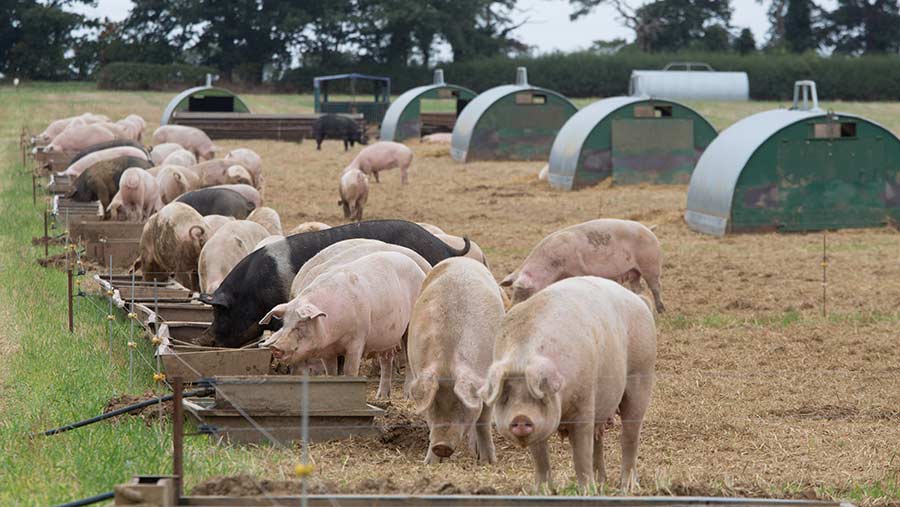Census shows more cereals, more pigs, fewer sheep and cattle
 © Tim Scrivener
© Tim Scrivener Cereal production in England has recovered after the wet autumn of 2019, with figures from the latest census on agriculture showing a 6.6% year-on-year increase in the acreage of combinable crops.
The data from Defra’s June Survey of Agriculture provides a snapshot of farmland use in England and livestock numbers, and reveals some interesting trends.
The total acreage of crops growing at June 2021 was 3.87m ha, a 1.9% increase on June 2020, with cereals excluding maize accounting for the biggest uplift of 6.6% to 2.69m ha.
However, oilseed production plummeted by 17.8% to 313,000ha.
Another sector that has experienced significant growth is pig production.
The national herd in June stood at 4.23m pigs, which represents a 5.4% increase on 2020.
This figure is likely to be a reflection of issues caused by the pandemic, Brexit and export and trade issues related to African swine fever (ASF).
Germany lost exports to China because of ASF and this had repercussions for the UK, as the majority of cull sows are exported to Germany.
Some UK abattoirs also lost export permits to China because of Covid.
Sows not in pig at the time of the census – suckled and dry pigs – accounted for the biggest uplift in numbers in the sector, with an increase of 15.9%.
It is the pig sector that also showed one of the biggest shifts within the data published on farmland use – land used for outdoor pigs rose by 17.8%, to 12,000ha.
See also: Railway fencing safety-what livestock farmers need to know
According to the survey, the proportion of arable land, permanent grassland, permanent crops and on-farm kitchen gardens – known as Utilised Agricultural Area – now accounts for 68% of land area in England, a total of 8.8m ha, compared with 74%, or 9.6m ha, when the data was first published in 1983.
Data by sector
Cereals
Total crops grown saw a 1.9% increase to 3.87m ha.
Wheat production experienced the biggest rise in production in the cereals sector – up 30.8% to 1.65m ha.
But there is less barley being grown – this year’s 8.16m ha represents a 21.9% reduction.
Spring barley took the biggest hit, down 40.5% between 2020 and 2021, to a total area of 4.7m ha, as sowings retuned to a more normal pattern after the weather-related disruptions to the 2020 crop areas and shares.
Rye grown for threshing saw a big uplift, up 55.2% to 37,000ha
Across all arable crops, spring-sown oilseed rape saw the biggest reduction in acreage grown, a 54.5% fall to 63,000ha.
Pigs
The national pig herd has grown by 5.4%, to 4,238,000 head, with sows not in pig at the time of the census – suckled and dry pigs – accounting for the biggest uplift of 15.9%.
All pig classes experienced increases, with just one exception – there were small dips in numbers of in-pig sows and gilts.
Numbers fell slightly in the female element of the breeding pig herd, which fell 0.5% to 303,000 head. However, there was an uplift across all fattening pig classes; this category experienced 6.1% growth overall, bringing numbers to 3,835,000 head.
Cattle
Nearly every cattle class is down in number.
For cattle overall, the size of the national herd has fallen to 5,071,000 head, with 1.9% fewer cattle and calves than in 2020.
It is a significant fall since 1984, when that figure stood at 7,974,000.
Male cattle aged two years or older saw the biggest drop, down 14.7% to 150,000.
Dairy cattle
Numbers of dairy animals aged two years or older fell by 0.9% in 2021 to 1.1m.
For other female cattle, the fall was bigger, down 14.1% to 130,000 animals.
The one dairy class that did record a rise in numbers was animals aged between one and two years, where there was a 1.6% increase to 309,000 head.
Beef cattle
The beef sector has also seen cattle numbers drop.
For cattle aged two years or older, there was a 3.3% fall to 665,000 animals.
As with dairy, there was a big drop in the other female cattle category, which fell 11.1% to 168,000.
Numbers of cattle aged between one and two years now stands at 466,000, a drop of 1.9%.
Sheep
The national sheep flock has contracted, with total sheep and lamb numbers down by 2.7% to 14.6m.
There are fewer breeding sheep – the figure now stands at 6.87m after a 1.5% drop.
The category covering other sheep and lambs saw numbers fall by 3.7%, to 7.75m
Land use
Arable production is by far the biggest use of farmland in England, with crops now covering 3.74m ha, 2.2% up on 2020.
Acreage of land down to permanent grassland has fallen slightly, down 3.3% to 3.59m ha, but there has been a 6.5% increase in temporary grassland – grassland sown in the past five years; this now accounts for 756,000ha of farmland.
A total of 131,000ha is down to horticultural crops.
Despite an environmental emphasis on growing more trees, there is less land dedicated to woodland than there was in 2020 – at 382,000ha this represents a slight fall of 0.8%.
